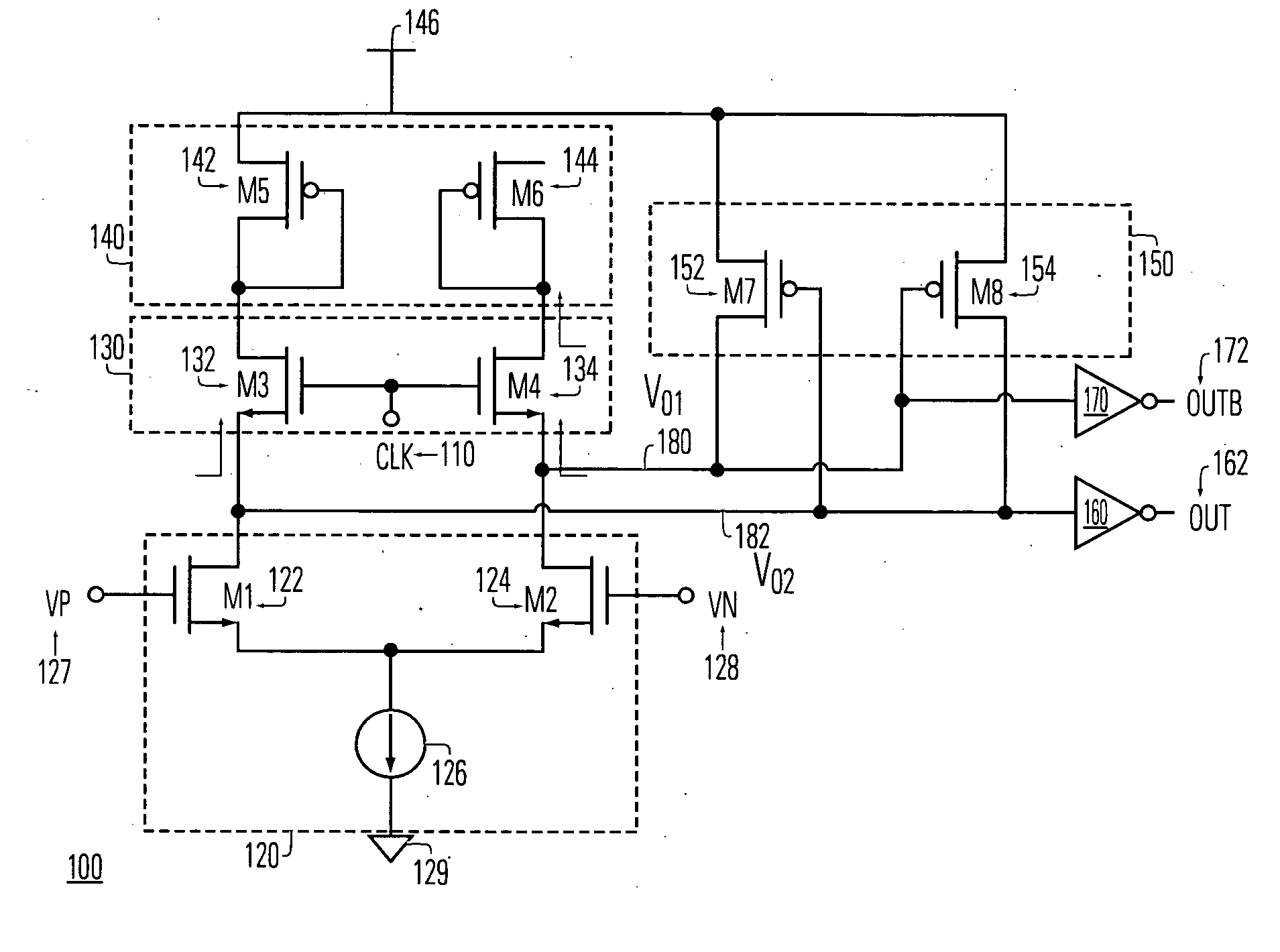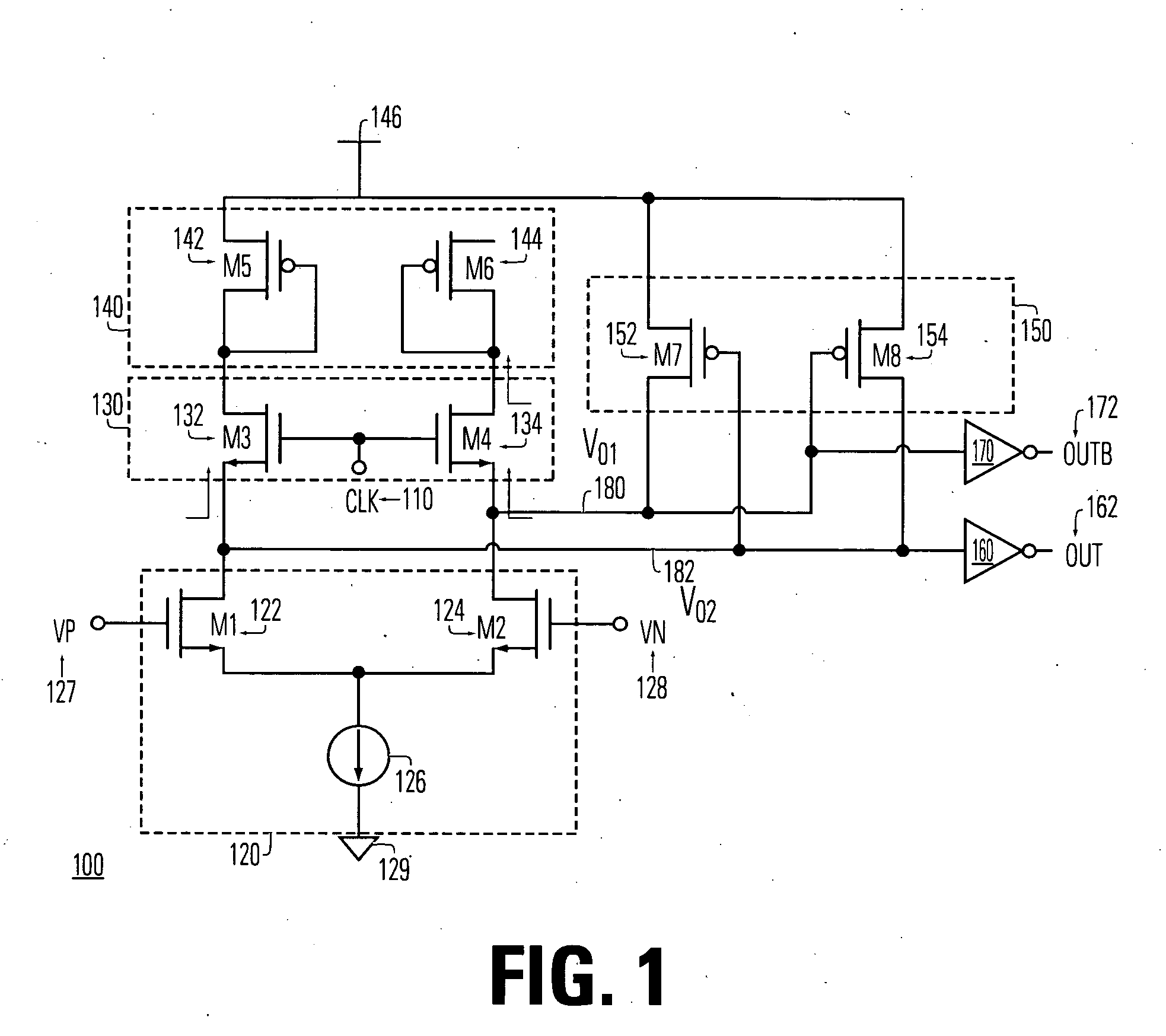Differential sense amplifier circuit and method triggered by a clock signal through a switch circuit
a switch circuit and amplifier technology, applied in the field of integrated circuits, can solve the problems of generating kickback noise at input, sensitivity to noise, and speed limitation by slew rate, and achieve the effect of increasing the speed of regeneration and stable amplification
- Summary
- Abstract
- Description
- Claims
- Application Information
AI Technical Summary
Benefits of technology
Problems solved by technology
Method used
Image
Examples
first embodiment
[0026] In FIG. 3, there is shown a circuit diagram illustrating the loop gain in the differential sense amplifier 100 in the first embodiment that functions as the preamplifier when the clock signal is set to the first signal level. In this configuration, when the clock signal is set to the first signal level, the M3 transistor 132 and the M4134 transistor are turned on, which also turn on the M5142 transistor and the M6144 transistor. The loop gain for the differential sense amplifier 100 that functions as an preamplifier can be calculated as follows:
Aloop=gm8[(ro3+ro5) / / (ro1 / / ro8)]*gm7*[(ro4+ro6) / / (ro2 / / ro7)]≈gm8*[ro2+ro5]*gm7*[(ro4+ro6)]ro1 / / ro8)>>(ro3+ro5); (ro2 / / ro7)>>(ro4+ro6) ∵gm8*[ro3+ro5]=gm7*[(ro4+ro6)]∵ro4=1 / gm4; ro6=1 / gm6
∴ The equation conforms to gm7*(ro4+ro6)32 >gm7*(1 / gm4+1 / gm6)<1
[0027]FIG. 4 is a circuit diagram illustrating the loop gain in the differential amplifier 200 in the first embodiment that functions as the latch circuit when the clock signal is set to t...
second embodiment
[0028] Turning now to FIG. 5, there is shown a circuit diagram illustrating a differential sense amplifier 500 that functions as a preamplifier when the clock signal is set to the first signal level and that functions as a latch circuit when the clock signal is set to the second signal level. In this embodiment, the differential sense amplifier 500 is designed with a R1 resistor 510 connected between the M3 transistor 132 and the Vdd voltage 146, replacing the M5142 transistor. A R2 resistor 520 is connected between the M4 transistor 134 and the Vdd voltage 146, replacing the M6144 transistor. In this embodiment, the differential sense amplifier 500 with the R1 resistor 510 and the R2 resistor 520 provides a larger input common mode range relative to the differential sense amplifier 100 as described in FIG. 1.
third embodiment
[0029] As shown in FIG. 6, there is a circuit diagram illustrating a differential sense amplifier 600 that functions as a preamplifier when the clock signal is set at the first signal level and that functions as a latch when the clock signal is set at the second signal level. The PMOS transistors 142 and 144 in FIG. 1 are replaced with NMOS transistors to generate the configuration in FIG. 6. The differential sense amplifier 600 comprises a pair of diode-connected transistors 610, the switch circuit 130, a differential amplifier 620, a positive feedback circuit 630, a first output inverter 640 and a second output inverter 650. The switch 130 includes the M3 transistor 132 and the M4 transistor 134 that are coupled, respectively, to the pair of diode-connected M5 transistor 612 and M6 transistor 614 on the lower side, and the differential pair 620 on the upper side. The positive feedback circuit 630 includes a M7 transistor 632 and a M8 transistor 634 that provide a positive feedback...
PUM
 Login to View More
Login to View More Abstract
Description
Claims
Application Information
 Login to View More
Login to View More - R&D
- Intellectual Property
- Life Sciences
- Materials
- Tech Scout
- Unparalleled Data Quality
- Higher Quality Content
- 60% Fewer Hallucinations
Browse by: Latest US Patents, China's latest patents, Technical Efficacy Thesaurus, Application Domain, Technology Topic, Popular Technical Reports.
© 2025 PatSnap. All rights reserved.Legal|Privacy policy|Modern Slavery Act Transparency Statement|Sitemap|About US| Contact US: help@patsnap.com



